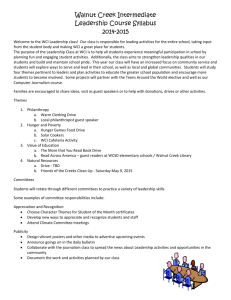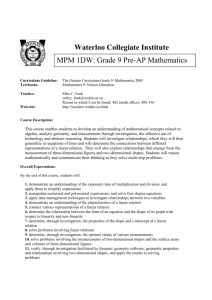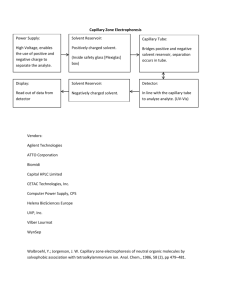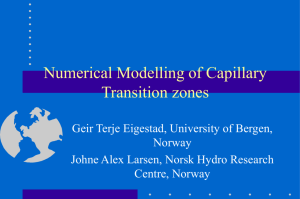Document 11808819
advertisement
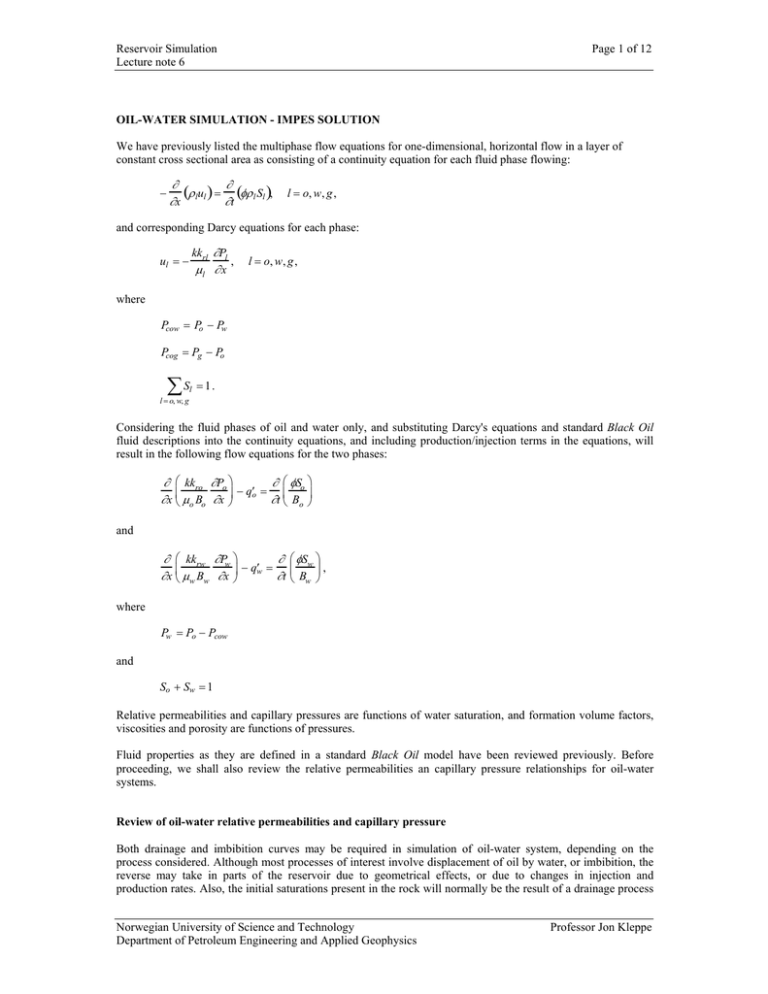
Reservoir Simulation Lecture note 6 Page 1 of 12 OIL-WATER SIMULATION - IMPES SOLUTION We have previously listed the multiphase flow equations for one-dimensional, horizontal flow in a layer of constant cross sectional area as consisting of a continuity equation for each fluid phase flowing: − ∂ ∂ (ρ u ) = (φρ l Sl ), ∂x l l ∂t l = o, w, g , and corresponding Darcy equations for each phase: kkrl ∂Pl , µl ∂ x ul = − l = o, w, g , where Pcow = Po − Pw Pcog = Pg − Po ∑S l = 1. l = o, w, g Considering the fluid phases of oil and water only, and substituting Darcy's equations and standard Black Oil fluid descriptions into the continuity equations, and including production/injection terms in the equations, will result in the following flow equations for the two phases: ∂ kkro ∂Po ∂ φS − q′o = o ∂x µo Bo ∂x ∂t Bo and ∂ kkrw ∂Pw ∂ φS − q′w = w , ∂x µw Bw ∂x ∂t Bw where Pw = Po − Pcow and So + Sw = 1 Relative permeabilities and capillary pressures are functions of water saturation, and formation volume factors, viscosities and porosity are functions of pressures. Fluid properties as they are defined in a standard Black Oil model have been reviewed previously. Before proceeding, we shall also review the relative permeabilities an capillary pressure relationships for oil-water systems. Review of oil-water relative permeabilities and capillary pressure Both drainage and imbibition curves may be required in simulation of oil-water system, depending on the process considered. Although most processes of interest involve displacement of oil by water, or imbibition, the reverse may take in parts of the reservoir due to geometrical effects, or due to changes in injection and production rates. Also, the initial saturations present in the rock will normally be the result of a drainage process Norwegian University of Science and Technology Department of Petroleum Engineering and Applied Geophysics Professor Jon Kleppe Reservoir Simulation Lecture note 6 Page 2 of 12 at the time of oil accumulation. Thus, for initialization of saturations, the drainage capillary pressure curve is required. Starting with the porous rock completely filled with water, and displacing by oil, the drainage relative permeability and capillary pressure curves will be defined: Pc Kr Drainage process oil water Sw=1 oil Pcd Swir Sw 1.0 1.0 Swir Sw Reversing the process when all mobile water has been displaced, by injecting water to displace the oil, imbibition curves are defined: Pc Kr Imbibition process oil Sw= Swir water water Swir 1-Sor Sw Swir 1-Sor Sw The above curves are typical ones for a completely water-wet system. For less water-wet systems, the capillary pressure curve will have a negative part at high water saturation. The shape of the curves will depend on rock and wetting characteristics. Discretization of flow equations We will use similar approximations for the two-phase equations as we did for one phase flow. Left side flow terms ∂ kkro ∂Po ≈ Txo i +1/ 2 (Po i+1 − Po i ) + Txo i −1/ 2 (Po i−1 − Po i ) ∂x µo Bo ∂x i and ∂ kkrw ∂Pw ≈ Txwi +1/ 2 (Pw i +1 − Pw i ) + Txw i−1 / 2 (Pw i −1 − Pw i ) , ∂x µw Bw ∂x i where, using oil term and plus direction as example, oil transmissibility is defined as Txoi +1/ 2 = 2 λ oi +1 2 ∆x ∆x ∆x i i+1 + i ki ki +1 and the oil mobility term is defined as λo = k ro µo Bo . Norwegian University of Science and Technology Department of Petroleum Engineering and Applied Geophysics Professor Jon Kleppe Reservoir Simulation Lecture note 6 Page 3 of 12 The mobility term is now a function of saturation in addition to pressure. This will have significance for the evaluation of the term in discrete form. Upstream mobility term Because of the strong saturation dependencies of the two-phase mobility terms, the solution of the equations will be much more influenced by the evaluation of this term than in the case of one phase flow. Recalling the Buckley-Leverett solution to the problem of displacing oil by water in a one-dimensional system, we will use it to illustrate the effect of mobility on the saturation solution: Here, for negligible capillary pressure, the water will move through the porous medium as a discontinuous front as illustrated in the figure above. In simulating this process, using a discrete grid block system, we will find that the results are very much dependent upon the way the mobility term is approximated. Two cases will be considered, using flow of oil between blocks i and i + 1 as an example: 1) upstream selection λ o i +1/ 2 = λ o i 2 )weighted average selection λ o i +1/ 2 = (∆x i λ oi + ∆xi +1 λo i +1 )/(∆x i + ∆x i +1 ) The results of these two selections on the saturation profiles calculated by the simulator are illustrated on the next page. Of course, the deviation from the exact solution depends on the grid block sizes used. For the downstream selection, water saturation behind the front may even become negative for large blocks. For very small grid blocks, the differences between the solutions may become negligible. Since the same amount of water has been injected in the three cases, the areas under the three curves must be equal, and only the location of the fluid front has been shifted, as well as the magnitude of the water saturation at the fluid front. The physical explanation of the differences, and in particular for the case of the weighted average mobility selection, is that the flow rate of oil out of any grid block depends primarily on the relative permeability to oil in that grid block. In particular, for flow between blocks i and i + 1 , the relative permeability of block i will determine when the flow is to stop (i.e. when the block has reached residual oil saturation). If the mobility selection is the weighted average, the block i may actually have reached residual oil saturation, while the mobility of block i + 1 still is greater than zero. Therefore, flow out of block i will not stop before the relative permeability of block i + 1 also has become zero. Again, for small grid block sizes, the error involved may be small, but for blocks of practical sizes, it becomes a significant problem. Qw Sw 1-Sor Swir exact average upstream x Norwegian University of Science and Technology Department of Petroleum Engineering and Applied Geophysics Professor Jon Kleppe Reservoir Simulation Lecture note 6 Page 4 of 12 Therefore, in reservoir simulation, upstream mobilities are normally used, and using the plus direction as example, for oil-water flow: upstream selection of mobility: λ oi +1 if Po i +1 ≥ Poi if P oi +1 < Poi λ oi +1/ 2 = λo i λ w i +1 if Pw i +1 ≥ P wi λ w i+1 / 2 = λ w i if Pw i +1 < Pw i Right side terms The right hand side of the oil equation may be expanded as follows: ∂ φSo φ ∂So ∂ φ + So . = ∂t Bo Bo ∂t ∂t Bo Since the derivative part of the second term is identical to the right hand side of the one phase equation, we may write an approximation for this directly: ∂φ φ cr d(1/ Bo ) ≈ i + (Po i − Po ti ) . ∂t Bo i ∆t Bo dPo i For the first term, we will replace oil saturation by water saturation, so that ∂Sw ∂S =− o . ∂t ∂t Then we may use a standard backward approximation of the time derivative, φ ∂So φi t B ∂t ≈ − Bo ∆t (Swi − Sw i ) . o i i i The complete difference form of the right hand side of the oil equation may thus be written as: ∂ φSo ≈ Cpooi (P oi − Po ti ) + Cswoi (Swi − Sw ti ) , ∂t Bo i where Cpooi = φi (1− Swi ) cr Bo + ∆t d(1/ Bo) , dPo i and Cswoi = − φi Bo i ∆ti . For the water equation, a similar expansion is carried: ∂ φSw φ ∂Sw ∂ = + Sw ∂t Bw Bw ∂t ∂t φ . Bw Norwegian University of Science and Technology Department of Petroleum Engineering and Applied Geophysics Professor Jon Kleppe Reservoir Simulation Lecture note 6 Page 5 of 12 The second term in this expression may be expanded further, to yield: ∂ φ ∂ φ ∂Pw ∂ φ ∂Po ∂Pcow . = = − ∂t Bw ∂Pw Bw ∂t ∂Pw Bw ∂t ∂t Since capillary pressure is a function of water saturation only, we may write: ∂Pcow dPcow ∂Sw = . ∂t dSw ∂t Using the one phase terms and standard difference approximations for the derivatives, the right side of the water equation becomes: ∂ φSw ≈ C pow i (Po i − Po ti ) + C swwi (Sw i − Sw ti ) , ∂t Bw i where Cpow i = φ i Swi c r and Cswwi = + ∆t Bw φi Bwi ∆ti d (1 / Bw ) , dPw i dP − cow C powi . dSw i The discrete forms of the oil and water equations may now be written as: T xoi +1 2 (Po i+1 − Poi ) + T xo i−1 2 (Po i −1 − Poi ) − q ′oi ( ) ( ) = C poo i Poi − Poit + C swoi Swi − Sw ti , [ ] [ i = 1, N ] T xwi+1 2 (Po i +1 − Poi ) − (Pcow i +1 − Pcowi ) + T xwi−1 2 (Po i −1 − Poi ) − (Pcow i−1 − Pcowi ) − qwi ′ ( ) ( ) = C pow i Po i − Po ti + C swwi Sw i − Swti , i = 1, N Complete definitions of the terms in the equations are given below: T xoi +1 2 = T xoi −1 2 = T xwi+1 2 = T xwi−1 2 = 2λ oi +1 2 ∆x i +1 ∆xi ∆x i + ki k i+1 2λ oi −1 2 ∆x ∆x ∆x i i −1 + i ki k i−1 2λw i +1 2 ∆x ∆x ∆x i i +1 + i k ki i +1 2λw i −1 2 ∆x ∆x ∆x i i −1 + i k ki i −1 where Norwegian University of Science and Technology Department of Petroleum Engineering and Applied Geophysics Professor Jon Kleppe Reservoir Simulation Lecture note 6 λo = Page 6 of 12 k ro µo Bo and the upstream mobilities are selected as: λ oi +1 if Po i +1 ≥ Poi λ oi +1/ 2 = λo i if P oi +1 < Poi λ oi −1 if Po i −1 ≥ Poi λo i if P oi −1 < Poi λ oi −1/ 2 = λ w i +1 if Pwi +1 ≥ P wi λ wi+1 / 2 = λ wi if Pwi +1 < Pw i λ w i−1 if Pwi −1 ≥ Pw i λ wi if Pwi −1 < Pwi λ wi−1 / 2 = The right side coefficients are: Cpooi = φi (1− Swi ) c r ∆t Cswoi = − C pow i = Cswwi = B + o d(1/ Bo ) dPo i φi Bo i ∆ti φ iSw i cr + ∆t Bw d(1/ Bw ) dPw i dP − cow C pow i . Bwi ∆ti dSw i φi The three derivative terms appearing in the expressions above: d(1/ Bo ) d(1/ Bw) , and dP o i dP w i dPc dSw i are all computed numerically for each time step based on the respective PVT and capillary pressure input tables to the model. Boundary conditions The boundary conditions for multiphase are as for one phase flow, but rates and pressures can be specified for each of the phases. Normally, we inject water in a grid block at constant surface rate or at constant bottom hole pressure, and produce oil and water from a grid block at constant bottom hole pressure, or at constant surface oil rate, or at a constant surface liquid rate. Sometimes we may want to specify constant reservoir voidage rate, where either the rate of injection of water is to match a specified rate of liquid production, so that average reservoir pressure remains constant, or the liquid production rate is to match a specified water injection rate. Constant water injection rate This is the simplest condition to handle, as a water rate term is already included in the water equation. Thus, for a constant surface water injection rate of Qwi (negative) in a well in grid block i: qwi ′ = Qwi /(A∆x i ) . Norwegian University of Science and Technology Department of Petroleum Engineering and Applied Geophysics Professor Jon Kleppe Reservoir Simulation Lecture note 6 Page 7 of 12 At the end of a time step, after having solved the equations, the bottom hole injection pressure for the well may theoretically be calculated using the well equation: Qwi = WCi λoi (Pw i − Pbhi ) . The well constant is defined as for one phase flow: 2π ki h r , ln( e ) rw where rw is the well radius and the drainage radius is theoretically defined as: WCi = re = ∆y∆xi π . However, the fluid injected in a well meets resistance from the fluids it displaces also. Therefore, as a better approximation, it is normally accepted to use the sum of the mobilities of the fluids present in the injection block in the well equation. Thus, the following well equation is often used for the injection of water in an oil-water system: k ro k rwi Qwi Bwi = WCi i + ( Pw i − Pbhi ) , µoi µ oi or B Qwi = WCi oi λ oi + λ wi ( Pw i − Pbhi ) Bwi By this approximation, the injection will be controlled by the oil mobility initially, when there is no or little water present in the grid block. At a later stage, the water mobility will take over the control. Injection wells are frequently constrained by a maximum bottom hole pressure, to avoid fracturing of the formation. This should be checked at the end of each time step, and, if necessary, reduce the injection rate, or convert it to a constant bottom hole pressure injection well. Frequently, capillary pressure is neglected in the well equation, particularly in the case of field scale simulation, so that the well equation becomes: B Qwi = WCi oi λ oi + λ wi ( Po i − Pbhi ) . Bwi However, in simulation of small scale systems, such as cores used in laboratory experiments, this may lead to significant errors. Injection at constant bottom hole pressure Injection of water at constant bottom hole pressure is achieved either by having constant pressure at the injection pump at the surface, or by letting the hydrostatic pressure caused by the well filled with water control the injection pressure. The well equation above is again used: B Qwi = WCi oi λ oi + λ wi ( Pw i − Pbhi ) Bwi or B Qwi = WCi oi λ oi + λ wi ( Poi − P bhi ) Bwi if the capillary pressure of the injection block is neglected. Since the (unknown) grid block pressure is included in the well equation, the corresponding terms must be included in the appropriate coefficients in the pressure solution. Norwegian University of Science and Technology Department of Petroleum Engineering and Applied Geophysics Professor Jon Kleppe Reservoir Simulation Lecture note 6 Page 8 of 12 At the end of the time step, the above equation may be used to compute the actual water injection rate for the step. Constant oil production rate For the oil equation, this condition is handled as for the constant water injection rate. Thus, for a constant surface oil production rate of Qo i (positive) in a well in grid block i : qoi′ = Qoi /( A∆x i ) . However, in this case oil production will generally be accompanied by water production, so that the water equation will have a water production term given by: qwi ′ = qoi′ λ wi ( Pw i − Pbhi ) . λ oi ( Po i − Pbhi ) In case the capillary pressure is neglected around the production well, the expression simply becomes: qwi ′ = qoi′ λ wi . λo i At the end of a time step, after having solved the equations, the bottom hole production pressure for the well may be calculated using the well equation for oil: Qoi = WCiλ oi ( Poi − Pbhi ) . Production wells are normally constrained by a minimum bottom hole pressure, for lifting purposes in the well. If this is reached, the well should be converted to a constant bottom hole pressure well. The water cut at the surface is: fwsi = qwi ′ . qwi ′ + q′oi Frequently, well rates are constrained by maximum water cut levels, due to limitations in process equipment. If a maximum water cut level is exceeded for a well, the highest water cut grid block may be shut in, or the production rate may have to be reduced. Constant liquid production rate Here, a total constant surface liquid production rate of QLi (positive) is specified for a well in grid block i: QLi = Qoi + Qwi , which, if capillary pressure is neglected, leads to: qoi′ = λ oi Q /( A∆x i ) λ oi + λ wi Li qwi ′ = λ wi Q /( A∆x i ) . λ oi + λ wi Li and Norwegian University of Science and Technology Department of Petroleum Engineering and Applied Geophysics Professor Jon Kleppe Reservoir Simulation Lecture note 6 Page 9 of 12 Production at constant reservoir voidage rate This condition may be illustrated by a case of constant surface water injection rate of Qwinj in some grid block, and the total production of liquids from a well in block i is to match the reservoir injection volume so that the reservoir pressure remains approximately constant. Thus, Qoi Boi + Qwi Bwi = −Qwinj Bwinj , which, again assuming that capillary pressure is neglected, leads to: qoi′ = λoi (−Qwinj Bwinj ) /( A∆xi ) λoi Boi + λwi Bwi q′wi = λwi (−Qwinj Bwinj ) /( A∆xi ) . λoi Boi + λwi Bwi and Production at constant bottom hole pressure Using a production well in grid block i with constant bottom hole pressure, Pbhi , as example, we have: Qo i = WCi λo i ( Po i − Pbhi ) and Qwi = WCi λwi ( Pw i − Pbhi ). Substituting the flow terms in the flow equations, we thus have: qoi′ = WCi λ oi ( Po i − Pbhi ) A∆xi qwi ′ = WCi λ wi ( Pw i − Pbhi ) . A∆xi and Since the rate terms contain unknown block pressures, these will have to be appropriately included in the matrix coefficients when solving for pressures. At the end of each time step, actual rates are computed by these equations, and water cut is computed as in the previous cases. Solution by IMPES method In the equations above, oil pressure, Poi , and water saturation, Swi , are the primary variables, and unknowns to be solved for. All the coefficients in the equations, transmissibilities as well as storage coefficients, are functions of these unknowns. In addition, the capillary pressures on the left side of the water equation are functions of saturation. Thus, we cannot solve the equations before the coefficients and the capillary pressures are calculated, and we cannot calculate the coefficients and the capillary pressures before the unknown pressures and saturations have been solved for. Obviously, a solution method is needed that either iterates on the solution and updates coefficients and capillary pressures until convergence is reached, or some other method for estimating the coefficients and the capillary pressures. IMPES is a simple method, but one that is still being used quite extensively today, although in decreasing extent. The acronym IMPES stands for IMplicit Pressure, Explicit Saturation method, and we will describe this method in detail in the following. In the IMPES method, the key lies in the approximation of coefficients and capillary pressures. It simply evaluates these at time level t , and thus enable us to solve for pressures and saturations without having to iterate on the solution. Thus, the following assumptions are made: Norwegian University of Science and Technology Department of Petroleum Engineering and Applied Geophysics Professor Jon Kleppe Reservoir Simulation Lecture note 6 Page 10 of 12 T xo t , Txw t C pot ,C pw t C so t ,C sw t Pcow . t Having made these approximations, the equations become: T xoit+1/ 2 (Po i +1 − Po i ) + Txo ti −1/ 2 (Poi −1 − Po i ) − qoi′ ( ) ( ) = Cpoo ti Po i − Po ti + Cswoit Swi − Sw it , [ [(P T xwti+1 / 2 (Poi +1 − Po i ) − (Pcowi +1 − Pcow i ) +T xwti−1 / 2 oi −1 t − Po i ) − (Pcowi −1 − Pcowi ( ) ( i = 1, N ] ) ]− q ′ t wi ) = C pow ti Poi − P oit + Csww ti Sw i − Sw ti , i = 1, N IMPES pressure solution Since water saturation only appear as Sw i on the right sides of the two equations, they may be combined to eliminate water saturation completely as an unknown from the equations. Thus, we may obtain a pressure equation as: (Txoti+1 / 2 + α i Txwti +1/ 2 )(Po i +1 − Poi )+ (Txoit −1/ 2 + α i Txwit−1/ 2)(P oi −1 − Po i ) − α iT xwti +1/ 2 (Pcowi +1 − Pcow i ) − α i Txwit−1/ 2 (Pcow i−1 − P cowi ) − qoi′ − α i qwi ′ = t (Cpoo ti + α iCpwoti )(P oi − Po ti ), i = 1, N where α i = −Cswwit / Cswoit . The pressure equation may now be rewritten as: ai Po i −1 + bi Po i + ci Po i+1 = di , i = 1, N where ai = T xoit−1/ 2 + α iT xwit−1 / 2 c i = T xoit+1 / 2 + α iT xwti +1/ 2 t t t bi = −(T xoi +1/ 2 + Txo i −1/ 2 + Cpooi ) − α i (T xwti+1 / 2 + T xwti −1/ 2 + Cpowit ) t t t di = −(Cpoo i + α iC pow i )P oi + q′oi + α iqwi ′ t t t t + α iT xwi+1 / 2 (Pcowi +1 − Pcow i ) + α i Txwi −1/ 2 (Pcow i −1 − Pcowi ) Norwegian University of Science and Technology Department of Petroleum Engineering and Applied Geophysics Professor Jon Kleppe Reservoir Simulation Lecture note 6 Page 11 of 12 Modifications for boundary conditions ′ . With the We have seen that all rate specified well conditions are included in the rate terms qoi′ and qwi coefficients involved at old time level, as for all other IMPES coefficients, these rate terms are already appropriately included in the di term above. For injection of water at bottom hole pressure specified well conditions, we have seen that the following expression apply (using the case of neglected capillary pressure as example, however, capillary pressure can easily be included): B Qwi = WCi oi λ oi + λ wi (Po i − Pbhi ) . Bwi In a block with a well of this type, the following matrix coefficients are modified: t t t bi = −(T xoi +1/ 2 + Txo i +1/ 2 + C pooi ) t WCi Boit t t t t − α i T xwi +1 / 2 + T xwi+1 / 2 + C pow i + t λoi + λ wi A∆x i Bwi di = −(Cpoo ti + α iC pow ti )P oit − t WCi t WCi Boi t λoi Pbhi − α i λ oi + λ twi Pbhi t A∆x i A∆xi Bwi + α iT xwti+1 / 2 (Pcowi +1 − Pcow i ) t + α i Txwit−1/ 2 (Pcow i −1 − Pcowi )t For production at bottom hole pressure specified well conditions, we have the following expressions: qoi′ = WCi λ oi (Po i − Pbhi ) A∆xi qwi ′ = WCi λ wi (Pw i − Pbhi ) . A∆xi and In a block with a well of this type, the following matrix coefficients are modified: bi = −(T xoit+1/ 2 + Txo it+1/ 2 + Cpooit + WCi t λ ) A∆x i oi − α i (T xwti+1 / 2 + T xwti +1/ 2 + Cpow it + di = −(Cpoo ti + α iC pow ti )P oit − t WCi t λ ) A∆x i wi WCi t WCi t λoi Pbhi − α i λ P bh A∆x i A∆xi wi i t t t + α iT xwi+1 / 2 (Pcowi +1 − Pcow i ) + α i Txwi −1/ 2 (Pcow i −1 − Pcowi ) The pressure equation may now be solved for oil pressures by using Gaussian elimination as we did in for one phase flow. IMPES saturation solution Having obtained the oil pressures above, we need to solve for water saturations using either the oil equation or the water equation. In the following we will use the oil equation for this purpose: T xoit+1/ 2 (Po i +1 − Po i ) + Txo ti −1/ 2 (Poi −1 − Po i ) − qoi′ ( ) ( ) = Cpoo ti Po i − Po ti + Cswoit Swi − Sw it , Norwegian University of Science and Technology Department of Petroleum Engineering and Applied Geophysics i = 1, N Professor Jon Kleppe Reservoir Simulation Lecture note 6 Page 12 of 12 Since water saturation only appears as an unknown in the last term on the right side of the oil equation, we may solve for it explicitly: Sw i = Sw it + [ ( 1 T xoit+1/ 2 (Po i +1 − Po i ) + Txo ti −1/ 2 (Poi −1 − Po i ) − qoi′ − C poo ti Po i − Po ti Cswoit )] , i = 1, N For grid blocks having pressure specified wells, we make appropriate modifications, as discussed previously: t Sw i = Sw i + 1 Cswoit [ T xo ti+1 / 2 (Poi +1 − Po i )+ Txo ti −1/ 2 (Po i−1 − P oi ) − ( WCi t λ (Po − P bhi ) − C poo ti Po i − Po ti A∆x i oi i ) ], i = 1, N Having obtained oil pressures and water saturations for a given time step, well rates or bottom hole pressures may be computed, if needed, from the following expression for an injection well: qwi ′ = WCi Boi λ + λ wi (Poi − Pbhi ) , A∆xi Bwi oi and for a production well: qoi′ = WCi λ oi (Po i − Pbhi ) A∆xi qwi ′ = WCi λ wi (Pw i − Pbhi ) . A∆xi and The surface production well water cut may now be computed as: fwsi = qwi ′ . qwi ′ + q′oi Based on these, we make required adjustments in well rates and well pressures, if constrained by upper or lower limits. Then all coefficients are updated before proceeding to the next time step. Applicability of IMPES method The approximations made in the IMPES method, namely the evaluation of coefficients at old time level when solving for pressures and saturations at a new time level, puts restrictions on the solution which sometimes may be severe. Obviously, the greatest implications are on the saturation dependent parameters, relative permeability and capillary pressure. These change rapidly with changing saturation, and therefore IMPES may not be well suited for problems where rapid variations take place. IMPES is mainly used for simulation of field scale systems, with relatively large grid blocks and slow rates of change. It is normally not suited for simulation of rapid changes close to wells, such as coning studies, or other systems of rapid changes. However, provided that time steps are kept small, IMPES provides accurate and stable solutions to a long range of reservoir problems. Norwegian University of Science and Technology Department of Petroleum Engineering and Applied Geophysics Professor Jon Kleppe
